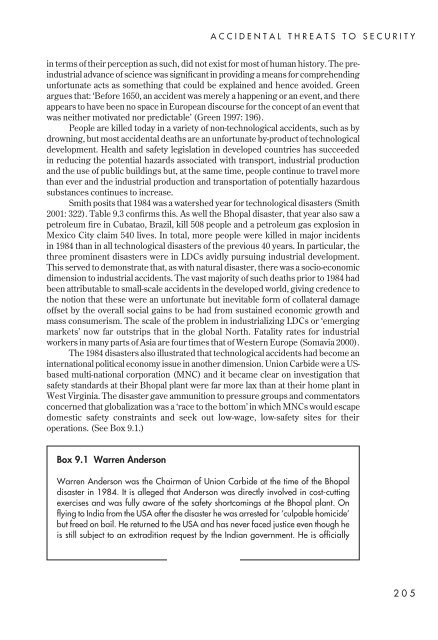Understanding global security - Peter Hough
Understanding global security - Peter Hough
Understanding global security - Peter Hough
You also want an ePaper? Increase the reach of your titles
YUMPU automatically turns print PDFs into web optimized ePapers that Google loves.
ACCIDENTAL THREATS TO SECURITY<br />
in terms of their perception as such, did not exist for most of human history. The preindustrial<br />
advance of science was significant in providing a means for comprehending<br />
unfortunate acts as something that could be explained and hence avoided. Green<br />
argues that: ‘Before 1650, an accident was merely a happening or an event, and there<br />
appears to have been no space in European discourse for the concept of an event that<br />
was neither motivated nor predictable’ (Green 1997: 196).<br />
People are killed today in a variety of non-technological accidents, such as by<br />
drowning, but most accidental deaths are an unfortunate by-product of technological<br />
development. Health and safety legislation in developed countries has succeeded<br />
in reducing the potential hazards associated with transport, industrial production<br />
and the use of public buildings but, at the same time, people continue to travel more<br />
than ever and the industrial production and transportation of potentially hazardous<br />
substances continues to increase.<br />
Smith posits that 1984 was a watershed year for technological disasters (Smith<br />
2001: 322). Table 9.3 confirms this. As well the Bhopal disaster, that year also saw a<br />
petroleum fire in Cubatao, Brazil, kill 508 people and a petroleum gas explosion in<br />
Mexico City claim 540 lives. In total, more people were killed in major incidents<br />
in 1984 than in all technological disasters of the previous 40 years. In particular, the<br />
three prominent disasters were in LDCs avidly pursuing industrial development.<br />
This served to demonstrate that, as with natural disaster, there was a socio-economic<br />
dimension to industrial accidents. The vast majority of such deaths prior to 1984 had<br />
been attributable to small-scale accidents in the developed world, giving credence to<br />
the notion that these were an unfortunate but inevitable form of collateral damage<br />
offset by the overall social gains to be had from sustained economic growth and<br />
mass consumerism. The scale of the problem in industrializing LDCs or ‘emerging<br />
markets’ now far outstrips that in the <strong>global</strong> North. Fatality rates for industrial<br />
workers in many parts of Asia are four times that of Western Europe (Somavia 2000).<br />
The 1984 disasters also illustrated that technological accidents had become an<br />
international political economy issue in another dimension. Union Carbide were a USbased<br />
multi-national corporation (MNC) and it became clear on investigation that<br />
safety standards at their Bhopal plant were far more lax than at their home plant in<br />
West Virginia. The disaster gave ammunition to pressure groups and commentators<br />
concerned that <strong>global</strong>ization was a ‘race to the bottom’ in which MNCs would escape<br />
domestic safety constraints and seek out low-wage, low-safety sites for their<br />
operations. (See Box 9.1.)<br />
Box 9.1 Warren Anderson<br />
Warren Anderson was the Chairman of Union Carbide at the time of the Bhopal<br />
disaster in 1984. It is alleged that Anderson was directly involved in cost-cutting<br />
exercises and was fully aware of the safety shortcomings at the Bhopal plant. On<br />
flying to India from the USA after the disaster he was arrested for ‘culpable homicide’<br />
but freed on bail. He returned to the USA and has never faced justice even though he<br />
is still subject to an extradition request by the Indian government. He is officially<br />
205
















